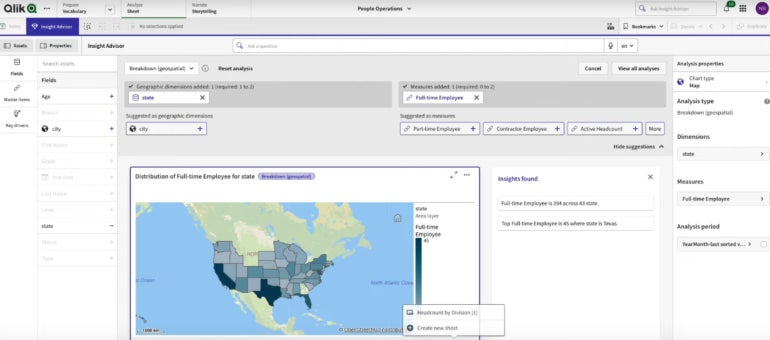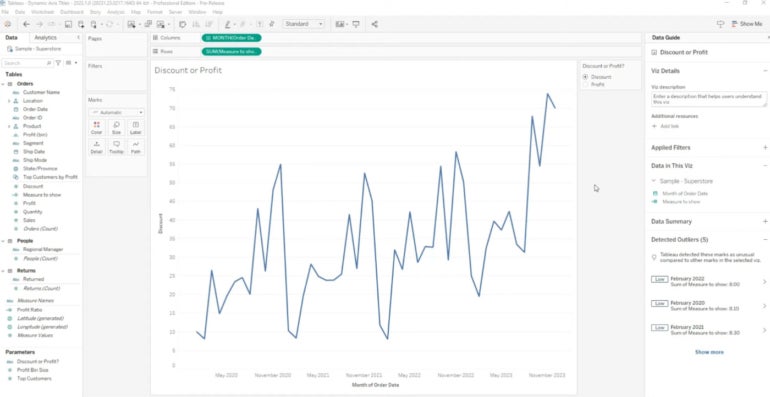
Qlik Sense and Tableau help business executives and decision-makers build data-driven strategies. With business intelligence features like automatic data collection, analysis and visualizations, organizations can save a lot of time and energy.
The two BI suites provide cloud-based services and allow users to create guided apps and dashboards from pretty much any source, but they don’t have the exact same approach and performances. Learn about the key features of Qlik Sense and Tableau to help you evaluate each solution and choose the right one according to your business context and expectations.
Jump to:
Qlik Sense is a BI tool that focuses on contextualization and security. It is particularly efficient for generating smart visualizations and mappings. In addition, Qlik Sense can perform analysis to combine data from multiple sources using the Qlik Analytics Engine, Qlik Sense’s associative technology for data discovery and artificial intelligence.
The Qlik Sense BI suite provides advanced configurations to power users. For example, the engine can take scripts as inputs to make predictions. It also caters to beginners, who can use the drag-and-drop interface to create applications with ease.

Tableau is a BI software that focuses on intuitiveness and does not require any preselection. Users with various levels of expertise can use it, but power users can add more filters and optimizations. That said, neither complicated macros nor advanced scripting is required to start.
Tableau is full of features and interactive visualizations. It can source data from multiple sources — such as custom databases, cloud services or Google Analytics — and combine all data natively. In addition, developers can query performant application programming interfaces to integrate Tableau into existing apps or websites.
Its capabilities are pretty high, including statistical, behavioral, multidimensional or predictive analysis. Additionally, its Einstein Discovery tool leverages Salesforce’s no-code platform and machine learning to predict new trends and deliver recommendations.
SEE: For more information, explore our Tableau cheat sheet.
| Features | Qlik Sense | Tableau |
|---|---|---|
| Ad hoc query and reports | Yes | Yes |
| Predictive analysis and machine learning | Yes | Yes |
| Bayesian and statistical analysis | Yes | Yes |
| Behavioral analytics | No | Yes |
| Benchmarking | Yes | Yes |
| OLAP (multidimensional analysis) | Yes | Yes |
| Relational display | No | Yes |
| Strategic planning | Yes | Yes |
| Mobile support for iOS and Android | Yes | Yes |
| Documentation or knowledge base | Yes | Yes |
Qlik Sense supports organizations that seek to reach deeper insights from their business data. The Sense solution can be purchased through three price plans. Those interested can take advantage of a 30-day free trial of Qlik Sense by signing up online.
In addition, Qlik has several other pricing tiers available for data integration needs:
In addition to a free tier, Tableau offers three paid tiers to enable users to discover insights through the analysis of their business datasets:
Tableau’s Creator edition includes tools to support businesses’ end-to-end data analytics workflows. For smaller businesses or teams with tighter budgets, Tableau’s Explorer and Virtual plans are less expensive, but they provide limited features and capabilities compared to the Creator edition. Those who are interested in Tableau should look into trying its 14-day free trial.
Tableau also offers a free app for Mac and Windows called Tableau Public. This is a limited option that allows anyone to create and share visualizations for free from public data sources and private data. All of these visualizations are hosted for free but are publicly searchable within the Tableau database.
Qlik Sense and Tableau provide advanced analysis tools and models. Users can create pipelines from multiple sources and leverage the benefits of machine learning to sort data.
SEE: Explore the differences between data modeling and data analysis.
However, Qlik Sense focuses on data association while Tableau promotes exploration for users with author permissions. In other words, Qlik Sense promotes the discovery of critical data relations that are easy to miss, while Tableau requires users to create their own searching pattern and find hints themselves (Figure A). While both software options help users find the data that will drive business decisions, Tableau may require more technical expertise to build insightful reports.
Figure A

Aesthetics and design can really make a difference when it comes to visualizations, as the idea is to highlight key figures and trends to make them easily understandable.
Tableau can generate visualizations that combine many design elements with data for reporting, apps, and dashboards that are designed for business and consumer audiences (Figure B). To see what others are doing with Tableau, users can explore its public gallery or data visualizations.
Figure B

Qlik Sense provides various predefined charts and custom objects that can be used and reused in sophisticated visualizations but with fewer graphical options, as the primary audience is business users. Qlik Sense has more granularity in the types of data combinations or drill-down options, but beginners might find the number of options a bit overwhelming.
That said, the end product includes the Insight Advisor feature, which gives business users the ability to query and use the data associations for self-service insights.
Tableau and Qlik Sense offer a decent level of safety. Their services rely on trusted data sources and other critical aspects of enterprise security, but Qlik Sense has better capabilities, especially regarding access control.
While Tableau complies with an extensive range of security obligations for data, cloud-based operations or network requests, Qlik Sense provides more granularity and access control, for example, with the Section Access that can reduce data to the appropriate scope.
It requires more technical skills, though, but power users and administrators may appreciate this possibility.
Before making a purchase decision, be sure to ask these questions:
Tableau and Qlik Sense are robust solutions with tools to help businesses gain more value from their data. Each can support a wide range of operating systems and web and mobile platforms. Users can access data and reports from almost every device, and each company has built a strong community and offers excellent support.
However, there are some differences to consider when choosing between Tableau and Qlik Sense. While both solutions use machine learning to identify trends and build robust models, Tableau requires far less technical expertise and is recognized as a reference in the industry. Furthermore, each tool provides a decent level of safety with services that rely on trusted data sources and other critical aspects of enterprise security. That said, Qlik Sense’s software does offer higher access control capabilities.
SEE: Not sure if Qlik Sense or Tableau are right for your needs? Check out these other top business intelligence tools.
This is a technical review using compiled literature researched from relevant databases. The information provided in this article is gathered from vendor websites or based on an aggregate of user feedback to ensure a high-quality review.